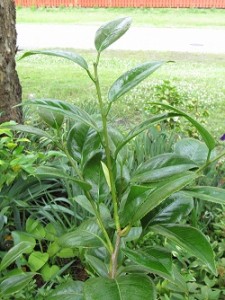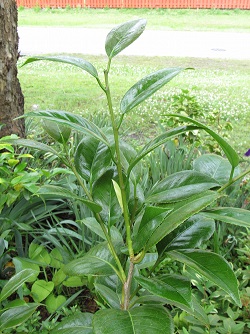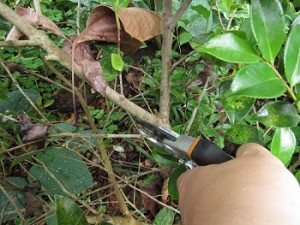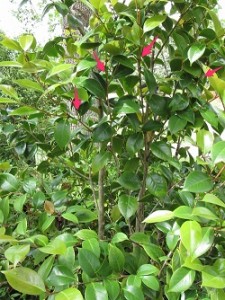If you grow azaleas and camellias, at some point you’ll need to prune them. Azaleas are universally viewed as hardy, easy-to-grow plants. Camellias, for some reason, have the reputation of being delicate flowers. That is hardly the case. Unless it is a variety that stays small (and there are a few of those) a happy camellia left to its own devices will grow into a dense, large, sprawling tree.

Here’s how to prune your Azaleas and Camellias so that they are big beautiful specimens.
When to Prune Camellias and Azaleas
Prune Azaleas and Camellias after they bloom and push the yearly flush of growth. Sasanqua camellias bloom in the fall and early winter. Japonica camellias bloom in the winter and spring. Azaleas bloom in spring. The exact month when you will want to prune these plants will differ depending on where you live and when the plants bloom.
After these plants bloom they immediately push new growth. Once the plants have finished with that first flush, you can trim to control size, open up the canopy, remove dead wood, and remove cRoss®ing branches. You could potentially prune right after the plants stop flowering, but you won’t have the benefit of seeing what that extra growth looks like. You might find yourself wanting to keep it.
What to Prune
I’ve outlined a little of that above.
1. Start by removing dead wood. This is often in the center of the plants. Cut dead branches back to the smallest living branch to start.
2. Thin out cRoss®ing or crowded branches. This will promote airflow in the canopy, which will cut down on disease problems. It will also allow for better light penetration, which means bigger, better blooms. Head back stragglers and branches that are sticking out and prune for size. I prune some azaleas in my front garden back by one-half every single spring because I don’t want them to get as tall as my house. They’re practically like weeds, so if I cut too much off, they’ll grow back. With camellias, just prune back to a branch. Azaleas are a little more forgiving. They’ll sprout from anywhere. There is a right and a wrong way to do this, aesthetically, at least. While you can cut an azalea branch anywhere, I like to kind of hide the cuts.
3. Head back stragglers and branches that are sticking out and prune for size. I prune some azaleas in my front garden back by one-half every single spring because I don’t want them to get as tall as my house. They’re practically like weeds, so if I cut too much off, they’ll grow back.
With camellias, just prune back to a branch. Azaleas are a little more forgiving. They’ll sprout from anywhere. There is a right and a wrong way to do this, aesthetically, at least. While you can cut an azalea branch anywhere, I like to kind of hide the cuts.
A Few Notes on Pruning
- Pruning stimulates growth. When you cut a branch, you remove the tip, which continually secretes hormones telling the buds lower on the branch not to sprout. Once you remove that growing tip, those buds will sprout. Be prepared.
- Pruning late in the fall can interfere with dormancy and lead to cold damage. Plants are working to harden off new growth and prepare for winter. Because pruning stimulates growth, if you prune in the fall, you’ll stimulate new, tender growth that doesn’t have time to prepare for cold weather.
- Pruning in late summer or winter will remove flower buds from azaleas and camellias, potentially interfering with the spring bloom. These plants set flower buds for the next spring during the summer after they finish blooming.
- If you prune too much, chances are the plant will grow back. After all, pruning stimulates growth. Don’t be nervous!
Katie Elzer-Peters gardens in the coastal town of Wilmington, North Carolina. She grows vegetables and has extensive mixed border gardens throughout her half acre property. She has a Bachelor of Science in Public Horticulture from Purdue University and a Master of Science in Public Horticulture from the University of Delaware and the Longwood Graduate Program. Katie has written eight books about gardening for Cool Springs Press.



